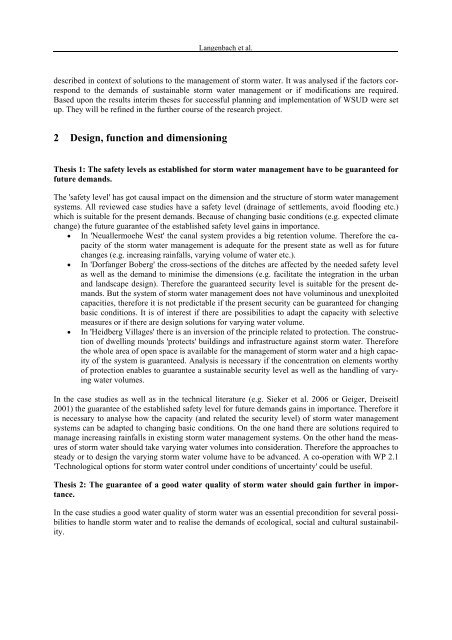Theses for the Future of Water Sensitive Urban Design (WSUD)
Theses for the Future of Water Sensitive Urban Design (WSUD)
Theses for the Future of Water Sensitive Urban Design (WSUD)
Create successful ePaper yourself
Turn your PDF publications into a flip-book with our unique Google optimized e-Paper software.
Langenbach et al.<br />
described in context <strong>of</strong> solutions to <strong>the</strong> management <strong>of</strong> storm water. It was analysed if <strong>the</strong> factors correspond<br />
to <strong>the</strong> demands <strong>of</strong> sustainable storm water management or if modifications are required.<br />
Based upon <strong>the</strong> results interim <strong>the</strong>ses <strong>for</strong> successful planning and implementation <strong>of</strong> <strong>WSUD</strong> were set<br />
up. They will be refined in <strong>the</strong> fur<strong>the</strong>r course <strong>of</strong> <strong>the</strong> research project.<br />
2 <strong>Design</strong>, function and dimensioning<br />
Thesis 1: The safety levels as established <strong>for</strong> storm water management have to be guaranteed <strong>for</strong><br />
future demands.<br />
The 'safety level' has got causal impact on <strong>the</strong> dimension and <strong>the</strong> structure <strong>of</strong> storm water management<br />
systems. All reviewed case studies have a safety level (drainage <strong>of</strong> settlements, avoid flooding etc.)<br />
which is suitable <strong>for</strong> <strong>the</strong> present demands. Because <strong>of</strong> changing basic conditions (e.g. expected climate<br />
change) <strong>the</strong> future guarantee <strong>of</strong> <strong>the</strong> established safety level gains in importance.<br />
• In 'Neuallermoehe West' <strong>the</strong> canal system provides a big retention volume. There<strong>for</strong>e <strong>the</strong> capacity<br />
<strong>of</strong> <strong>the</strong> storm water management is adequate <strong>for</strong> <strong>the</strong> present state as well as <strong>for</strong> future<br />
changes (e.g. increasing rainfalls, varying volume <strong>of</strong> water etc.).<br />
• In 'Dorfanger Boberg' <strong>the</strong> cross-sections <strong>of</strong> <strong>the</strong> ditches are affected by <strong>the</strong> needed safety level<br />
as well as <strong>the</strong> demand to minimise <strong>the</strong> dimensions (e.g. facilitate <strong>the</strong> integration in <strong>the</strong> urban<br />
and landscape design). There<strong>for</strong>e <strong>the</strong> guaranteed security level is suitable <strong>for</strong> <strong>the</strong> present demands.<br />
But <strong>the</strong> system <strong>of</strong> storm water management does not have voluminous and unexploited<br />
capacities, <strong>the</strong>re<strong>for</strong>e it is not predictable if <strong>the</strong> present security can be guaranteed <strong>for</strong> changing<br />
basic conditions. It is <strong>of</strong> interest if <strong>the</strong>re are possibilities to adapt <strong>the</strong> capacity with selective<br />
measures or if <strong>the</strong>re are design solutions <strong>for</strong> varying water volume.<br />
• In 'Heidberg Villages' <strong>the</strong>re is an inversion <strong>of</strong> <strong>the</strong> principle related to protection. The construction<br />
<strong>of</strong> dwelling mounds 'protects' buildings and infrastructure against storm water. There<strong>for</strong>e<br />
<strong>the</strong> whole area <strong>of</strong> open space is available <strong>for</strong> <strong>the</strong> management <strong>of</strong> storm water and a high capacity<br />
<strong>of</strong> <strong>the</strong> system is guaranteed. Analysis is necessary if <strong>the</strong> concentration on elements worthy<br />
<strong>of</strong> protection enables to guarantee a sustainable security level as well as <strong>the</strong> handling <strong>of</strong> varying<br />
water volumes.<br />
In <strong>the</strong> case studies as well as in <strong>the</strong> technical literature (e.g. Sieker et al. 2006 or Geiger, Dreiseitl<br />
2001) <strong>the</strong> guarantee <strong>of</strong> <strong>the</strong> established safety level <strong>for</strong> future demands gains in importance. There<strong>for</strong>e it<br />
is necessary to analyse how <strong>the</strong> capacity (and related <strong>the</strong> security level) <strong>of</strong> storm water management<br />
systems can be adapted to changing basic conditions. On <strong>the</strong> one hand <strong>the</strong>re are solutions required to<br />
manage increasing rainfalls in existing storm water management systems. On <strong>the</strong> o<strong>the</strong>r hand <strong>the</strong> measures<br />
<strong>of</strong> storm water should take varying water volumes into consideration. There<strong>for</strong>e <strong>the</strong> approaches to<br />
steady or to design <strong>the</strong> varying storm water volume have to be advanced. A co-operation with WP 2.1<br />
'Technological options <strong>for</strong> storm water control under conditions <strong>of</strong> uncertainty' could be useful.<br />
Thesis 2: The guarantee <strong>of</strong> a good water quality <strong>of</strong> storm water should gain fur<strong>the</strong>r in importance.<br />
In <strong>the</strong> case studies a good water quality <strong>of</strong> storm water was an essential precondition <strong>for</strong> several possibilities<br />
to handle storm water and to realise <strong>the</strong> demands <strong>of</strong> ecological, social and cultural sustainability.
















